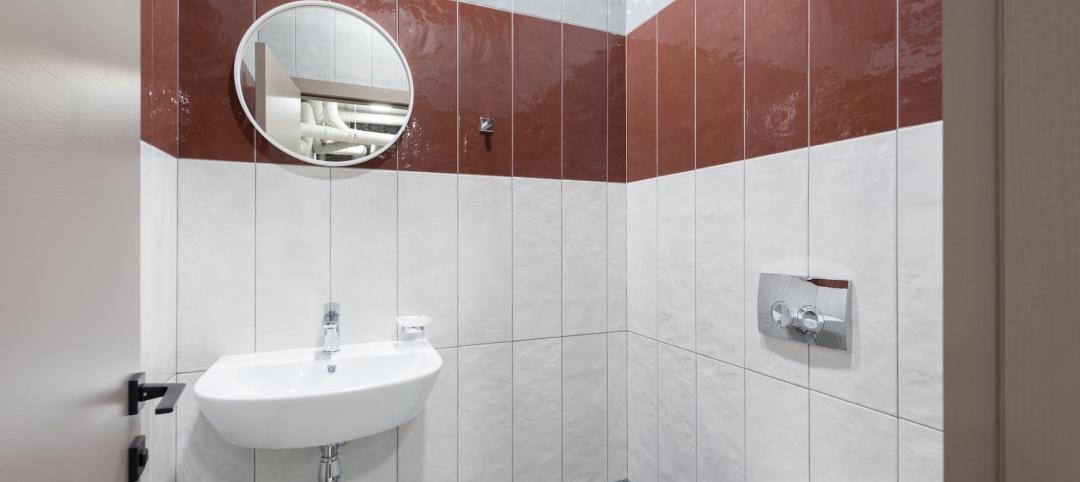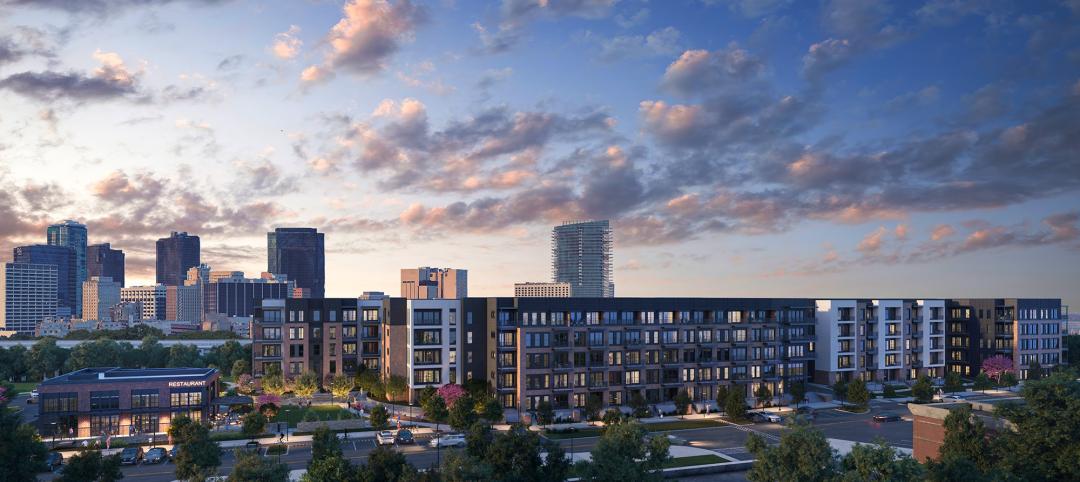Building Teams and their clients tend to think of a decorative concrete contractor as just another trade to be fit into the construction schedule, preferably at the lowest possible cost. But installing decorative concrete can be a delicate process, making planning for the construction crucially important.
At one time, decorative concrete came in only a few finishes—colored concrete, acid-etch stained, and stamped patterns. Today, there’s an almost infinite number of finishes available for horizontal and vertical surfaces—stamped, textured, integral and dust-on, colored, acid etch, dye (water and solvent), stampable overlays, self-level overlays, micro-toppings, stencil, engraved, form liners, diamond polished, sandblast, exposed aggregate, and coatings (epoxy, urethane, and acrylic). Finishes can also be combined with other finishes.
The possibilities are limited only by creativity of the designer and concrete contractor, yet it’s that very creativity that makes using decorative concrete so attractive. The problem is that concrete is very sensitive to a wide range of variables that can negatively impact the outcome.
ALSO SEE: 8 Innovations That Will Rock Your Next Concrete Project
To learn more about how to control these variables and thereby make decorative concrete a successful component of your next project, we consulted Mike Miller, Managing Principal of The concretist, Benicia, Calif. (www.theconcretist.com), one of the oldest decorative concrete contractors in the business. The term “concretist” refers to “one who practices concrete poetry,” and Miller himself is widely known for the almost poetic nature of his work.
1. Correctly assess—and manage—client expectations.
Miller says projects should start with the owner providing a full description, preferably in writing, of what the finished product should look like. Then the contractor can respond with what’s physically, aesthetically, and financially feasible. Sometimes owners have unreasonable expectations; early discussion can help manage those expectations.
What Building Teams should do when specifying decorative concrete:
1. Correctly assess—and manage—client expectations.
2. Choose the right decorative concrete contractor.
3. Carefully schedule the work of other trades to avoid undue damage to the concrete.
4. Provide the right protection for the finished work.
5. Negotiate an agreement with the client/owner on post-occupancy maintenance.
Decorative concrete usually isn’t structural in nature, although specifications are often written as if they were. For instance, a specification might require concrete with high compressive, tensile, or flexural strengths cured in a prescriptive manner. Or a specification might require “green concrete” with a certain percentage of the portland cement substituted with fly ash, slag cement, or other pozzolanic materials.
Miller’s advice: Focus first on the requirements for a good decorative installation; otherwise the work might meet all the structural requirements but be rejected for aesthetic reasons. For example, applying the usual curing specification for plain concrete to decorative work could have disastrous results, to the point of permanently damaging the look of decorative work. He urges Building Teams to use pre-job conferences to focus on the “dryness” of concrete or the slab relative humidity needed to start finish work rather than how to retain more moisture for curing purposes.
2. Choose the right decorative concrete contractor.
There can be significant variations in the creative abilities of decorative concrete contractors, says Miller. If you want highly creative work you must find a contractor who can perform at that level and who also possesses good craft skills. Contractors tend to specialize in certain types of decorative concrete these days, so you’ll have to narrow your search to get the right one for your job.
A word of caution: Miller says some decorative concrete contractors don’t place-and-finish concrete and wouldn’t know how to do it if asked, so you might have to hire a place-and-finish concrete contractor in addition to a decorative specialist.
3. Carefully schedule the work of other trades to avoid undue damage to the concrete.
Unfortunately, decorative concrete is highly susceptible to damage by other trades, more so than tile or other finished floor surfaces. Damage to concrete slabs can occur before decorative work begins or afterwards. Plumbers have been known to spill cutting oil, hot solder, and plastic pipe glue on slabs. Carpenters seem to think that any flat surface was put there so that they could pile stacks of lumber on it. Even trade workers’ footprints on floors that are hard but still considered “green” can become visible when acid-stain finishes are applied. Shoe soles also contain oils that may act as a resist.
To avoid conflicts with other trades, Miller recommends scheduling this work starting on a Friday afternoon and proceeding through a weekend. With no one on the job site to cause problems or delays, he says that’s the best chance for success.
4. Provide the right protection for the finished work.
The common belief about concrete is that it gets hard, becomes even stronger over time, and that’s pretty much it—no need to worry further. But that is not the case. Concrete remains vulnerable because its chemistry continues to change as it ages, and water on slab surfaces can bring about other physical and chemical changes. That’s why it’s so important to include a plan for protecting the finished work in pre-job meeting discussions.
Miller says covering material must allow moisture vapor from concrete to pass through while not allowing products that can stain to reach the surface of the concrete. The responsibility for the finished work is not a trivial matter. Since the concrete contractor cannot be expected to stay on the job until the concrete has fully cured, the responsibility for protecting the decorative work falls to the general contractor. However, that does not absolve the decorative contractor of all responsibility. The subcontractor should suggest the best protective products to use and perhaps even install them the first time.
5. Negotiate an agreement with the client/owner on post-occupancy maintenance.
A long-term maintenance plan should be part of the discussion your Building Team has with the client and facilities staff before construction begins. There are several ways to seal decorative work; each sealer provides a unique appearance. If an owner wants a glossy “wet look,” an epoxy, polyaspartic urethane, or acrylic finish is a good choice. These finishes must be renewed per the manufacturer’s recommendation. The accepted standard is that pedestrians should walk on the sealer, not on the concrete.
ALSO SEE: The world’s first building made from carbon-fiber reinforced concrete starts construction in Germany
If the owner wants a natural concrete look without a glossy appearance, there are penetrating sealers on the market that restrict pore openings so that dirt and other staining materials will not penetrate the surface.
Diamond-polished floors present additional maintenance problems. Owners typically want these floors to have a high-gloss shine, but dirt and fine grit become abrasive under foot traffic, dulling the surface gloss over time. Some big-box retail companies have maintenance programs to remove dirt and grit on a frequent schedule. In grocery stores food spillage must also be removed and cleaned as it occurs.
The inspirational aspect of decorative concrete
There are good reasons for the growing popularity of decorative concrete. It’s in our nature as humans to surround ourselves with creative expression and color; we like to be emotionally pleased by our environment.
Today, there are many more options for Building Teams to provide that kind of satisfaction through the use of decorative concrete. That’s why it’s important for Building Teams to work with their decorative concrete contractors to meet these heightened client expectations and ensure a long and useful life for these beautiful, inspiring surfaces. +
--
Joe Navsik, a freelance writer in the Chicago area, is a former editor at Concrete Construction magazine.
Related Stories
K-12 Schools | Feb 13, 2024
K-12 school design trends for 2024: health, wellness, net zero energy
K-12 school sector experts are seeing “healthiness” for schools expand beyond air quality or the ease of cleaning interior surfaces. In this post-Covid era, “healthy” and “wellness” are intersecting expectations that, for many school districts, encompass the physical and mental wellbeing of students and teachers, greater access to outdoor spaces for play and learning, and the school’s connection to its community as a hub and resource.
Codes | Feb 9, 2024
Illinois releases stretch energy code for building construction
Illinois is the latest jurisdiction to release a stretch energy code that provides standards for communities to mandate more efficient building construction. St. Louis, Mo., and a few states, including California, Colorado, and Massachusetts, currently have stretch codes in place.
Market Data | Feb 7, 2024
New download: BD+C's February 2024 Market Intelligence Report
Building Design+Construction's monthly Market Intelligence Report offers a snapshot of the health of the U.S. building construction industry, including the commercial, multifamily, institutional, and industrial building sectors. This report tracks the latest metrics related to construction spending, demand for design services, contractor backlogs, and material price trends.
Retail Centers | Feb 4, 2024
‘Safe bathroom’ technology prevents fatal drug overdoses in public restrooms
‘Safe bathroom’ technology developed by a Massachusetts electrician has been proven to prevent fatal drug overdoses in public restrooms across the country. The systems use ultrasonic and infrared motion sensors connected to timers that detect slight body movements. When a system doesn’t sense motion within a set time period, it raises an alarm alerting emergency medical teams.
Standards | Feb 1, 2024
Prioritizing water quality with the WELL Building Standard
In this edition of Building WELLness, DC WELL Accredited Professionals Hannah Arthur and Alex Kircher highlight an important item of the WELL Building Standard: water.
Industry Research | Jan 23, 2024
Leading economists forecast 4% growth in construction spending for nonresidential buildings in 2024
Spending on nonresidential buildings will see a modest 4% increase in 2024, after increasing by more than 20% last year according to The American Institute of Architects’ latest Consensus Construction Forecast. The pace will slow to just over 1% growth in 2025, a marked difference from the strong performance in 2023.
Construction Costs | Jan 22, 2024
Construction material prices continue to normalize despite ongoing challenges
Gordian’s most recent Quarterly Construction Cost Insights Report for Q4 2023 describes an industry still attempting to recover from the impact of COVID. This was complicated by inflation, weather, and geopolitical factors that resulted in widespread pricing adjustments throughout the construction materials industries.
Hotel Facilities | Jan 22, 2024
U.S. hotel construction is booming, with a record-high 5,964 projects in the pipeline
The hotel construction pipeline hit record project counts at Q4, with the addition of 260 projects and 21,287 rooms over last quarter, according to Lodging Econometrics.
Modular Building | Jan 19, 2024
Virginia is first state to adopt ICC/MBI offsite construction standards
Virginia recently became the first state to adopt International Code Council/Modular Building Institute off-site construction standards.
Mixed-Use | Jan 19, 2024
Trademark secures financing to develop Fort Worth multifamily community
National real estate developer, investor, and operator, Trademark Property Company, has closed on the land and secured the financing for The Vickery, a multifamily-led mixed-use community located on five acres at W. Vickery Boulevard and Hemphill Street overlooking Downtown Fort Worth.

















